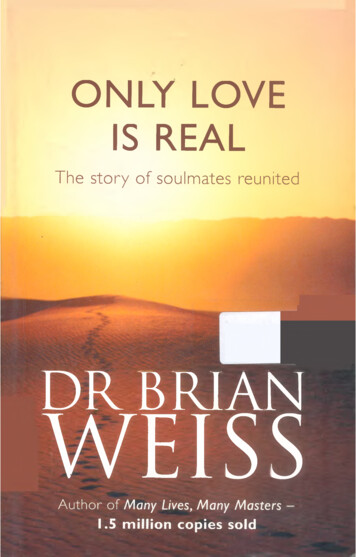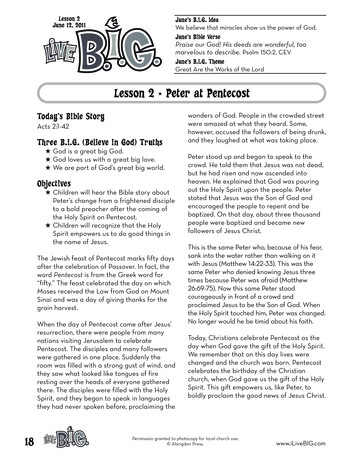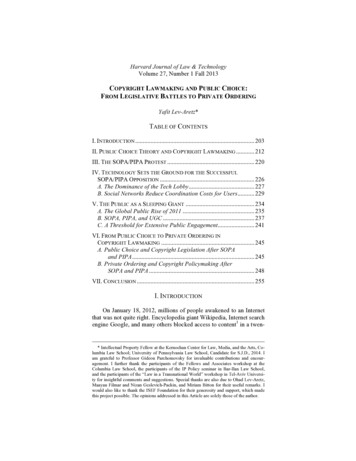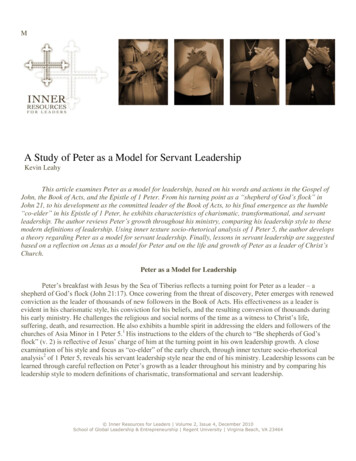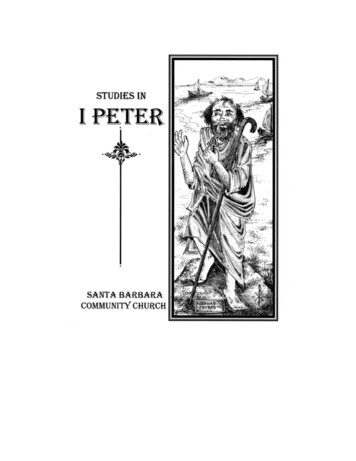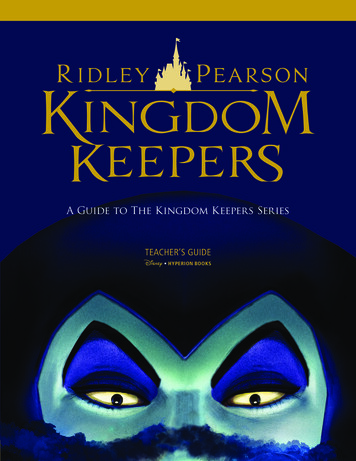
Transcription
CopyrightbyPeter Okie Weiss2012
The Report Committee for Peter Okie WeissCertifies that this is the approved version of the following report:“Jive That Anybody Can Dig:”Lavada “Dr. Hepcat” Durst and the Desegregation of Radio in CentralTexas, 1948-1963APPROVED BYSUPERVISING COMMITTEE:Supervisor:Karl Hagstrom MillerJacqueline Jones
“Jive That Anybody Can Dig:”Lavada “Dr. Hepcat” Durst and the Desegregation of Radio in CentralTexas, 1948-1963byPeter Okie Weiss, B.A.ReportPresented to the Faculty of the Graduate School ofThe University of Texas at Austinin Partial Fulfillmentof the Requirementsfor the Degree ofMaster of ArtsThe University of Texas at AustinAugust 2012
DedicationThis report is dedicated to anyone who works to honor the past, present or futureof Austin’s African American community. As Eva Lindsey says, “it’s going to take morethan folklore.”
AcknowledgementsMy sincere thanks to the University of Texas Department of History, Dr. KarlHagstrom Miller, Dr. Jacqueline Jones, Dr. Judith Coffin, Dr. Tiffany Gill, Dr. H. W.Brands, Marilyn Lehman, John Wheat, The Dolph Briscoe Center for American History,The Austin History Center, The George Washington Carver Museum and CulturalCenter, The Lyndon B. Johnson Presidential Library, The Texas State HistoricalAssociation, KVET, KUT, Dr. Martha Norkunas and the Project in Interpreting the TexasPast, and the Durst Family, especially those members I interviewed: Charles A. Durst,Ruthie M. Earls-Durst, Reginald Durst, Bernie C. Durst, Donnie D. Durst, Evada M.Durst-Jackson, and Cheryl Jackson. My deep gratitude also to Eva Lindsey, MaydieLindsey, Marvin Douglas, Patsy Stephenson, Dr. Beulah Agnes Curry Jones, Dr. ClayShorkey, Margaret Moser, Ron Chandler, Moton Crockett, Harold McMillan, BerthaMeans, Dr. James Polk, William C. Akins, John Hanson, Paul Ray, George Christian,Mickey Herskovitz, Preston Lauderbach, Jason Mellard, Franz Hensel and Blake Scott.Special thanks and love to Susan Okie, Walter Weiss, Jacob Weiss, and Nicole Berland.v
Abstract“Jive That Anybody Can Dig:”Lavada “Dr. Hepcat” Durst and the Desegregation of Radio in CentralTexas, 1948-1963Peter Okie Weiss, M.A.The University of Texas at Austin, 2012Supervisor: Karl Hagstrom MillerLavada “Dr. Hepcat” Durst was the first African American popular music discjockey in Texas. His radio program The Rosewood Ramble was broadcast on Austinstation KVET-1300 AM from 1948 until 1963. KVET’s white owners, who includedfuture Texas politicians John Connally and J. J. “Jake” Pickle, were not outspokenadvocates for the rights of African Americans under Jim Crow, but they hired Durst in aconcentrated effort to expand KVET’s African American listening audience. TheRosewood Ramble became a cultural, economic, and psychological resource for blackradio listeners in segregated central Texas while also becoming the region’s most popularradio show among white listeners. This paper uses a mixture of oral history and archivalsources to argue that Durst’s fifteen-year career at KVET was only the best-known partof a lifetime spent as an information broker to Austin’s embattled black community.vi
Table of ContentsList of Illustrations . ixTEXT.1Bibliography .69vii
List of IllustrationsIllustration 1: Lavada Durst, station KVET.1Illustration 2: Goddess of Liberty Statue, Texas Capitol Grounds.24Illustration 3:KVET Advertising Mailer.38Illustration 4: Lavada Durst Promotion for Grand Prize Beer.60Illustration 5:Cover, Book of Jive Talk.61viii
Photo of Lavada Durst, station KVET (Austin, Texas), LAB General Photograph Collection, Library ofAmerican Broadcasting, University of Maryland.1
“Hey there chappies. H’lo, chicks. You’ve latched on to the Rosewood Ramble with yourmusic recorded. It’s a real gone deal that I’m gonna wheel, so stand by while I pad yourskulls.”1Lavada “Dr. Hepcat” Durst delivered this monologue over the mellow strains of aDuke Ellington instrumental every weeknight from the summer of 1948 until 1963. Itprovided the overture to his rhythm & blues radio program The Rosewood Ramble onKVET-1300 AM in Austin, Texas. His voice, at first shocking to members of white andblack communities alike, soon became a fixture of the sonic landscape of post-WorldWar II central Texas. His words, the first ever spoken by a black secular music deejay onTexas airwaves, signaled to the listener that he or she had entered a space where theSouth’s traditional rules of African American deference were suspended, where a bold,boastful black voice could ring out from car radios and whisper sweet nothings into themost private corners of one’s home. The title of the Ellington track playing underneath,“Things Ain’t What They Used To Be,” could suggest either a nostalgia for the past or acelebration of the present. On the night of Dr. Hepcat’s first broadcast, Austin’s radiolisteners likely shook their heads in disbelief, some in delight, some in dismay, but all inagreement that a new era had begun. Things weren’t what they used to be.The desegregation of Austin’s airwaves was driven not by activism but byfinancial interest. Fledgling radio station KVET hired Lavada Durst at a time when thefuture of American broadcasting was uncertain. With television ownership on the rise,radio stations across the country were eager to prove to advertisers that their medium wasstill relevant. One of their strategies was to seek out new sets of listeners, and a handful1 David Isay, “Dr. Hepcat,” in Holding On: Dreamers, Visionaries, Eccentrics and otherAmerican Heroes (Newton, NJ: Shanachie Entertainment, 2005), Radio Documentary.2
of stations in the Jim Crow South decided that focusing on racial and ethnic minorityaudiences was their best chance for survival. KVET’s white owners were no socialprogressives, but they brought in Lavada Durst to, in his words, “put on a program andbeam it directly to black people.”2 Durst’s vast knowledge of contemporary AfricanAmerican music, combined with his mastery of the rhythmic, rhyming banter known asjive talk, soon made The Rosewood Ramble the most popular radio program in Austin.KVET’s surprised owners gladly reaped the financial benefits, but they nonethelessremained uneasy about Durst’s presence at their station.Durst himself was more businessman than race activist, a savvy entrepreneur wholiterally talked his way into mainstream broadcasting. Always dressed in colorful sportcoats, ties and a porkpie hat, Durst was different from the black professionals andacademics whose wealth and respectability had earned them influence with Austin’swhite officials earlier in the century.3 Durst also had little in common with hiscontemporaries Arthur DeWitty and Booker T. Bonner, political activists who openlychallenged Jim Crow’s hold in Austin. Durst stood between two eras of black activismand belonged to neither of them. A reluctant pioneer, he lived at a time when the effectsof America’s involvement in World War II created a moment of economic opportunity –albeit it limited – for African Americans. He used his entrepreneurial talent to becomeEast Austin’s foremost communicator, building a career at the intersections of music,sports, religion, advertising and teaching. The thing that linked all of his ventures was his2 Cheryl Coggins Frink, “Dr. Hepcat’s Jive Shattered Barrier of All-White Radio: ‘Soul-bending,Soul-sending’ Later Gave Way to Soul-saving,” Austin American-Statesman, March 8, 1987,A14.3 Author’s interview with Ron Chandler, November 16th, 2010, Austin, TX. Unless otherwisenoted, all interviews were conducted by the author.3
talk: cool and seductive, positive and reassuring, it gave him the power to traversedifferent spaces within and without Austin’s black community at a time when there werereal risks for doing so. Durst was a bridge between postwar Austin’s east and west, whiteand black, young and old, sacred and secular, and cultural and political worlds.Lavada Durst’s story also complicates our understanding of the role of business inthe long civil rights movement. In most narratives white-owned businesses appear asopponents of change: lunch counters that refused to desegregate or department stores thatrefused to let African Americans try on clothing. Rarely does one read about businessowners in the Jim Crow South making public deals across the color line. However,successful entrepreneurs tend to be comfortable with calculated risk, and in this sensethey have something in common with civil rights activists who were willing risk arrest orbodily harm to end Jim Crow. In both business and politics, success requires an ability tobalance liabilities against potential payoffs. When Durst and KVET co-founder JohnConnally shook hands in 1948, they knew they could face consequences for disturbingthe status quo in segregated Austin. However, each also knew that the payoff could besignificant: for KVET, tapping into an underserved radio market could keep the stationafloat; for Durst, radio could provide both an income and an opportunity to use his uniqueskill set for the benefit of his underserved community.Communications scholars Tom McCourt and Eric Rothenbuhler use LavadaDurst’s story to make arguments about structural change in the postwar American radioindustry.4 Cultural historians Nelson George and William Barlow focus on the influence4 Eric Rothenbuhler and Tom McCourt, “Radio Redefines Itself, 1947-1962,” in Radio Reader:Essays on the Cultural History of Radio, ed. Michele Hilmes and Jason Loviglio (New York:Routledge, 2002), 367-71.4
of Durst’s radio jive upon subsequent generations of radio broadcasters.5 These areimportant, national stories. But the local histories – of the marginalized East Austinneighborhood in which Durst grew up, of his path to radio, and of the lifelong work hedid to sustain black family life – have largely been unwritten. Radio was not a whollyseparate part of Durst’s career; it was only the most visible (or audible) part of a lifespent as an information broker to a community with a history of geographic andpsychological isolation. Durst played multiple roles in the upkeep of an independentblack Austin: advertiser, youth athletic director, sportscaster, clergyman, performingmusician, agent, booker, promoter, and songwriter. He was an ordained Baptist ministerwho gave up music for God, then returned to it in the final decade of his life. He was afather of two, a grandfather of many, and a surrogate father to thousands more throughhis work in the parks, churches and schools. I seek to situate his work at KVET withinthis larger picture.There is no surviving recording of The Rosewood Ramble.6 There are also veryfew formal histories of Austin’s black community.7 To assemble a more complete pictureof what Dr. Hepcat sounded like – and of his life and careers outside the deejay booth – Irelied on recorded interviews with Durst and on interviews I performed with those who5 Nelson George, The Death of Rhythm and Blues (New York: Pantheon Books, 1988), 43;William Barlow, Voice Over: The Making of Black Radio (Philadelphia: Temple UniversityPress, 1999), 93.6 Durst said he was unaware of any recordings of his show. See Ruth Ellsworth interview withLavada Durst, May 18th, 1978, Austin, Texas; John Wheat interview with Lavada Durst, 1986,Austin, Texas.7 See Anthony Orum, Power, Money, & the People: The Making of Modern Austin (Austin:Texas Monthly Press, 1987); Dwonna.Goldstone, Integrating the 40 Acres: The Fifty YearStruggle for Racial Equality at the University of Texas (Athens: University of Georgia Press,2006); Albert Arthur Allison, To Defy The Monster (New York: iUniverse, 2005); MarthaNorkunas, Project in Interpreting the Texas Past and the African American Texans Oral HistoryProject, both unpublished oral histories.5
knew him and/or listened to his program. For descriptions of East Austin during hislifetime, I used both my own interviews and secondary sources that employed oral historyas their primary methodology. Thus, much of this project is based in memory, in somecases recalled many years after the fact. This methodology is not without its pitfalls, butit offers the reward of documenting pieces of a past that would otherwise be lost. It wasthe only way to get an idea of the Ramble sounded like, of what Ernie’s Chicken Shacksmelled like, of how it felt to be a teenager at a Dr. Hepcat-deejayed dance in RosewoodPark on a sweltering summer night.Memory alone, says activist Eva Lindsey, is not enough to save East Austin. Sheargues that it will take “more than folklore” to stop the bulldozers of gentrification andurban redevelopment that are steadily erasing the Austin black community’s past and itspresent. 8 Lindsey wrote the application for historic landmark status that saved theVictory Grill from demolition in the 1990s. In the process, she learned that citingscholarly publications mentioning your endangered location is the best way to secure itspreservation. The collective memory of African Americans, she says, is too easilydismissed by white policymakers. It must be legitimated, turned into history, before it canbe wielded as a political weapon. And in many ways, Durst himself was a legitimator: heused his position at KVET to bring elements of African American vernacular culture tothe mainstream, where they could – and did - become part of white Austin’s history, too.Many Austinites, both black and white, disapproved of the culture that Durst wascelebrating. But even their disapproval was an acknowledgement of his power to shapetheir city’s identity.8 Interview with Eva Lindsey, November 15th, 2010, Austin, TX.6
The Rosewood Ramble was a cultural resource that encouraged Austinites toimagine themselves as living within a new postwar America; Austin radio listeners cameface-to-face for the first time with jive talk and rhythm and blues music, cultural formsthat owe their existence to the rapidly changing geographic and economic position ofAfrican Americans between World War I and World War II.9 Even if the most rapiddevelopments for blacks were happening in places far from Austin, Dr. Hepcat couldbeam their emergent musical expression directly into any home within range of KVET’s35-mile broadcast signal.10The Rosewood Ramble was also an economic resource that linked black andwhite, urban and rural, and sacred and secular communities much further afield than 35miles. Durst’s on-air promotion of black music helped put Austin on the Chitlin’ Circuit,an informal corridor of African American performance venues that stretched from NewYork to Texas. The Circuit created economic opportunities not only for musicians but forentrepreneurs in the communities in which they lived. East Austin’s thriving cultureindustry of the 1950s kept black dollars within the black community, and it also startedan eastward flow of young whites eager to experience live the music they heard onDurst’s program.Most importantly, however, The Rosewood Ramble was a psychological resourcefor black Austin during Jim Crow. Durst addressed individual black central Texans in away that broadcast media had never done, affirming their value as listeners while placingwhite listeners for the first time on the outside of a mainstream media discourse. As9 See George, The Death of Rhythm and Blues, 19; Preston Lauterbach, The Chitlin Circuit andthe Road to Rock and Roll (New York: Norton, 2011), 103.10 The KVET broadcast radius varied based on weather conditions and time of broadcast.Interview with Ron Chandler; Interview with John Hanson, November 16th, 2010, Austin, TX.7
Huston-Tillotson College’s Dean emeritus of fine arts and music Dr. Beulah Agnes CurryJones puts it, Dr. Hepcat’s jive technique made his program “a two-way street he wastalking to you with phraseology that made you feel acknowledged.”11 For once, blacklisteners were not made to feel that they were eavesdropping on a conversation betweenothers, or to rephrase W.E.B DuBois’ famous formulation of double consciousness,“[hearing] oneself through the [ears] of others.” In this way, Dr. Hepcat provided notonly a cultural and economic bridge between Austin’s east and west, its white and blackworlds, but also a psychological bridge between the words “black” and “Austinite.”12 Heoffered an identity to young black radio listeners that was based on participation inemergent, nationwide black cultural expressions; as it happened, many young whitesgravitated towards this identity as well.In 1870, African Americans made up 36.5% of Austin’s population.13 That wasthe highest proportion of the total that the black community ever reached. Its share fellsteadily since then, with larger drops from 1880 to 1890 and from 1910 to 1920. Thesewere the decades when lynching in Texas reached peak levels. In 1885, an estimatedtwenty-two mobs lynched forty-three people statewide. In the second decade, whichencompasses Lavada Durst’s birth in 1913, the onset of World War I saw a revival of theKu Klux Klan, and the number of lynchings in Texas more than doubled from prewarlevels. For the black Texas families that did not migrate north, the memory and threat of11 Interview with Dr. Beulah Agnes Curry Jones, October 28th, 2011, Austin, TX.12 W.E.B. DuBois, The Souls of Black Folk (Oxford: New York: Oxford University Press, 2007,first published 1903), 12. For more on double consciousness and black radio listening to showslike Amos n’ Andy, see Michelle Hilmes, Radio Voices: American Broadcasting, 1922-1952(Minneapolis: University of Minnesota Press, 1997), 93-94.13 U.S. Census.8
racial violence were constant presences.14 “It was instilled in me, stay away from thosewhite folks,” Durst later said. “They’ll tell a lie on you and get you hung.”15For most of Austin’s history, to “know one’s place” carried both geographic andbehavioral meanings, and to transgress those boundaries carried very real risks.16 In 1928,Austin city officials hired Dallas architectural firm Koch and Fowler to draw up a planfor Austin’s growth. One of the plan’s first recommendations was to relocate the city’sspread-out African American population into an area “east of East Avenue and south ofthe city cemetery” to make room for more desirable west side development.17 Theproblem was, Koch and Fowler admitted, that “this problem cannot be solved legallyunder any zoning law known to us at present. Practically all attempts of such have beenproven unconstitutional.”18 Clarksville and Wheatville, two neighborhoods on Austin’swest side established by emancipated slaves after the Civil War, were in 1928 still largelyfilled with black property owners. The city council’s solution was to deny these residentsmunicipal services if they did not willingly vacate. Instead of picking up blackhomeowners’ garbage, trucks dumped the city’s garbage in front of their houses.19Strategies like these proved effective. The 1940 census shows that seventy-five percent ofAustin’s black residents lived on the East side.20 Thus, one of the first steps in Austin’sredefinition as a modern city was to make black bodies invisible to middle-class whites,14 John R. Ross, “Lynching,” Handbook of Texas rticles/jgl01. Accessed November 15th, 2011.15 Wheat interview with Durst.16 Interview with Dr. Beulah Agnes Curry Jones. Dr. Jones said that many people couldn’tbelieve that she grew up on Red River Street “because it’s not far enough east.”17 Koch and Fowler, A City Plan for Austin, Texas (1928), 57. George Washington CarverMuseum and Cultural Center, Austin, TX.18 Orum, 175-176.19 Ibid, 175.20 U.S. Census.9
sequestering them into space that could ignored and underfunded for the next halfcentury.21A few black neighborhoods in other parts of the city persisted on into thetwentieth century, namely Clarksville to the west, St. John’s to the north, and South Maryto the south across the Colorado River. But the center of black life during Lavada Durst’slifetime was unquestionably the East side, and its residents came to view the Clarksvilleand St. John’s families as lower-class and poorer.22 Dr. Curry Jones remembers (andregrets) making fun of her classmates from St. John’s who were bused to E. H. AndersonHigh School on the East side in the 1940s.23The majority of Austin’s black residents were in the employ of whites. Theycrossed East Avenue each morning to work as maids, cooks, and groundskeepers in whiteresidential neighborhoods like Hyde Park and West Enfield. Some worked as janitors fordowntown department stores like J. C. Penney’s and E. H. Scarboroughs, while otherswere porters at hotels like the Driskill and Stephen F. Austin. The city’s electricstreetcars, which operated from 1891 to 1940, had a hub at the corner of CongressAvenue and East 6th Street.24 As black workers returned home in the evening fromvarious sections of the city, they were all forced to get off at the corner and wait for theone car that would take them to the East side. Since no downtown business would allow21 For the east side’s ongoing isolation from sources of “economic well-being, civic pride, andenvironmental meaning” in Austin, see Andrew Busch, “Natural City: The Unresolved Dialecticof Race, Economy, and Environment in Austin, 1955-1975,” University of Texas at Austin,unpublished paper, 5.22 Orum, 186.23 Interview with Dr. Beulah Agnes Curry Jones.24 A. T. Jackson, “Austin's Streetcar Era,” The Southwestern Historical Quarterly, Vol. 58, No. 2(Oct., 1954), 235-248.10
them to use the restroom, the were at times forced to urinate or even defecate in the alleysbetween buildings.25Not all black Austinites depended upon whites for their income, however.Minority entrepreneurs, shut out of Austin’s downtown business sector, created aninformal economy to meet the demands of their community. When Durst was a youngman, a walk down Austin’s East 6th street was like stepping into a smaller version of NewYork’s Lower East Side.26 Black, Hispanic, Jewish and Middle Eastern shopkeepersoffered their goods and services to white, black and brown customers. Jewish clothiersand dry goods merchants had begun arriving in Austin around the turn of the century, andthey had done business with African Americans from the start. Jonas Silberstein’s store at305 East 6th St. was one of the few places in the city where blacks could try on clothingbefore they bought it. As one ventured further east along East 6th Steet, immigrant-ownedbusinesses gave way to almost exclusively black- and Tejano-owned ones. AfricanAmerican dentist Dr. Everett Givens practiced at 419 1/2 East 6th, and black undertakerWilliam Tears had his mortuary at #615. The street would retain its identity as a minoritybusiness district until the 1970s; this was the commercial strip where Lavada Durst wouldhone his verbal advertising skills in the 1930s and 1940s. 27The East side’s entrepreneurs operated on the margins of the city’s white businesssector, and consequently some of the services they provided blurred the lines of legality.Often, these were the services that most enticed whites to cross East Avenue. Until hisdeath in 1932, black entrepreneur Nathan W. Rhambo owned a funeral parlor and a burial25 Orum, 184.26 ibid, 177.27 ibid, 180.11
insurance company, while he also ran the East side’s “policy,” or numbers game. Hereportedly employed Huston and Tillotson professors as accountants for both his legaland extralegal activities. His ascension to the post of treasurer in the Texas NegroUndertakers Association allowed him to extend his numbers racket across central Texas.Meanwhile, his brother Perry C. Rhambo was one of the East side’s biggest landowners,and he operated the neighborhood’s most successful barbershop in addition to severalbordellos.28 Perry had been a porter at the Stephen F. Austin Hotel in the early 1920s,where he also was a pimp to the white clientele, until he bought a house in East Austinand opened his first brothel. Bootleggers and cowboys rubbed shoulders with statehouselobbyists, politicians, and university students.29The Rhambos’ business ventures do not appear to have kept them from becomingrespected and influential citizens. East Austin was only five square miles, and virtue andvice had to exist in close proximity. Nathan and Perry Rhambo gave generously to theEbenzer Third Baptist Church and the Rising Star Baptist Church.30 In the wake of a1918 Ku Klux Klan rally at the Texas Capitol, Nathan Rhambo was named to a Welfareand Advisory Board charged with keeping “in intimate touch with the varied interest ofthe colored people of Austin ” and reporting monthly to the Austin city council.31 Whilelittle came of the board’s recommendations, its membership roll provided a virtual who’swho of black Austin that included Rhambo’s fellow mortician William Tears, physicianDr. W. H. Crawford, and dentist Dr. Everett Givens. In 1928 the Welfare and Advisoryboard finally secured 14,000 for the construction of a park for the black community.28 For land ownership, see Orum, 182, 187.29 Allison, 3.30 ibid, 3.31 Orum, 191.12
Named Rosewood Park, it would soon become the center of young black life in Austinand the place where Lavada Durst’s daytime and nighttime careers would intersect.Dr. Givens, the dentist, became the leading spokesman for Austin’s blackcommunity in the 1930s and 1940s. Called the “Bronze Mayor of Austin,” he developeda close working relationship with Tom Miller, who served as Austin’ mayor from 19331949 and 1955-1961.32 Givens was a graduate of Tillotson College, one of Austin’s twoblack colleges at the time, and of Howard University’s College of Dentistry. He was aphysically imposing man and a good orator who periodically addressed the Austin citycouncil, taking up large amounts of time with petitions for better street lighting, access tohealth care, and school revenues for East Austin. He later supported Lavada Durst whenmembers of the African American community complained about Durst’s jive talk ormusic selection on KVET. Whenever there was a problem, Givens would speak with theparties, and the complaints would stop.33Dr. Givens conspicuously never sought integration, only separate but equalfacilities for blacks. During a debate over public housing in 1949, he came out against theconstruction of a new project in North Austin, saying that “[racial] understanding will beseriously hurt if we try to go to [sic] fast.”34 Later activists like Arthur DeWitty wouldconsider Givens an “Uncle Tom.”35 But throughout the 1940s he was a thorn in the sideof the white establishment, demanding that both the city and state government follow“separate but equal” to the letter. The same day that KVET went on-air in 1946, Dr.32 Floylee Hunter Hemphill Goldberger, “Miller, Robert Thomas,” Handbook of Texas rticles/fmi21. Accessed July 31st, 2012.33Ada Simond, “Dr. Hep Cat Uses Insights of Disc Jockey to Aid Ministry,” Austin AmericanStatesman, Sunday, August 5th, 1984, B14.34 Austin American, November 5th, 1949.35 Orum, 253.13
Givens was the subject of a front-page article of the Austin Statesman. He had filed a suitin state court to force Texas to establish a branch university for blacks because he“desired to take a refresher course in dentistry and dental surgery and no suchinstruction was available to Negroes in Texas.”36 Given’s lawyer, Kenneth Lampkins,decided to stay clear of the NAACP’s impending attack on the “separate but equal”interpretation of the 14th Amendment of the U.S. Constitution. Instead, he cited the TexasConstitution, which provided for the creation of a branch university for blacks. Texas wasbending over backwards to avoid complying: beginning in 1939, the state had agreed topay the tuition of any African American who sought an advanced degree so long as theyleft Texas to do it.37 The Texas court found against Givens, but the NAACP brought thehigher education issue to federal court later that year in Sweatt v. Painter.38There were influential women in East Austin’s black middle class as well. MaryBranch was the president of Tillotson College from 1930 to 1944, and she served aspresident of the city’s NAACP chapter in 1943. A Virginian by birth, Branch had beenserving as dean of the largest school for black girls in the country, Vashon High Schoolin St. Louis, when the American Missionary Association recruited her to rescue theirfoundering institution in Austin. Though she was initially reluctant to come to Texas, sheeventually relented, saying “I thought of the numbers of white teachers who had goneSouth for years since the Civil War.they had made greater sacrifices than I would be36 “Law Suit Asking Negro University For Austin Filed,” Austin American-Statesman, Tuesday,October 1st, 1946, A1.37 Goldstone, 16.38 Gary M. Lavergne, Before Brown: Heman Marion Sweatt, Thurgood Marshall and the LongRoad To Justice (Austin: University of Texas Press, 2010), 87-8814
called upon to make.”39 In many ways Branch was Texas’ answer to Mary MacleodBethune; she was the state’s first black female college president, and in 1935 she servedon the Texas division of the National Youth Administration’s Negro Advisory Board. Inthis capacity, Branch worked to ensure that the New Deal’s jobs programs benefittedblack Texans as well as white.During her time at Tillotson she grew the student body from 140 to 502 student
literally talked his way into mainstream broadcasting. Always dressed in colorful sport coats, ties and a porkpie hat, Durst was different from the black professionals and academics whose wealth and respectability had earned them influence with Austin's white officials earlier in the century.3 Durst also had little in common with his
